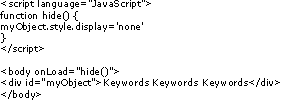Recently Google blacklisted BMW’s German
website for violating its guidelines. According to the verdict termed as the "Google death penalty", "BMW" or "BMW Germany" will not return a direct link to the car company's German website, bmw.com.de for artificially enhancing its popularity on Google. Furthermore, bmw.com.de's PageRank has been reset to zero. Initially the site was removed for three day, but it really gave goose bumps the SEO Community because the bmw.com.de notoriously became the highest profile companies till date to suffer the “Google death penalty. It heavily relied on
java script code that was unsearchable by Google’s spider and used text-heavy pages profusely scattered with key words to attract the attention of Google's indexing system.
What actually happened was that the cloaking was tactfully embedded in the
webpage. A picture of what a
search engine spider visiting the home page of the German BMW website saw, and what a user’s browser saw were very different. The spider was fed a page full of text containing words “gebrauchtwagen” (used car) and “neuwagen” (new car) many tens of times and not much else, and for the surfer there was a more standard-looking web page with smart pictures of automobiles and use of each of those words maybe twice.
It came as a surprise for everybody that how such a high-profile website got engaged in black hat SEO tactics and how such a global site that is geared to other countries, could abide with the disappearance of one of its national sites. It could have happened probably due to the company’s carelessness. They might not have checked the credibility of the
SEO Company before hiring them. But the SEO professionals can’t be foolish enough to know that those JavaScript redirects could lead to the site being removed. Every second company uses this black-hat SEO tactic and that ways BMW is not any exception. This has left so many webmasters perplexed, because still it is not known to them that what raged Google.
BMW has already suffered the wrath because the search term "BMW" still direct web surfers to the main worldwide site, but for the lesser companies such a penalty could be catastrophic because in that case their visitors/customers might end up being directed elsewhere.
Now you might be wondering what Google requires to re-include the site in its catalog. Fundamentally Google wants that the site should get rid of all those JavaScript redirects then submit a re inclusion request. As such Google also has the right to know the SEO Company who optimizes the web pages and tell them what they exactly did. But in case of BMW Google wants the company to include details on who created the doorway pages, and an assurance that such pages won’t appear again before the re-inclusion of the domains.


